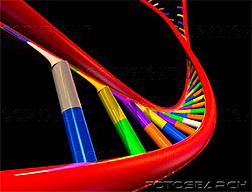This page has been archived and is being provided for reference purposes only. The page is no longer being updated, and therefore, links on the page may be invalid.
|
|
Gene Variants Affecting Blood Fats Identified
By Rosalie Marion BlissJanuary 26, 2009
A team of researchers has identified new genetic sites harboring common variations in DNA that are linked to imbalances in concentrations of blood lipids (fats). The findings provide another step forward in understanding the genetic contribution to dyslipidemia, a condition marked by overproduction of low-density lipoprotein (LDL "bad" cholesterol) and triglycerides, and underproduction of high-density lipoprotein (HDL "good"cholesterol).
The extensive research team included senior author and nutrigenomics expert Jose Ordovas of the Jean Mayer USDA Human Nutrition Research Center on Aging (HNRCA) at Tufts University in Boston, Mass. The HNRCA is funded by the Agricultural Research Service (ARS), a scientific research agency of the U.S. Department of Agriculture. The study was headed by Boston-based Massachusetts General Hospital physician Sekar Kathiresan.
For the first stage of the study, the researchers analyzed data from seven "genome-wide association" studies. Together, these studies provided more than 2.6 million DNA markers, called single nucleotide polymorphisms, or SNPs, from 19,840 individuals. These SNPs were then tested for associations with lipoprotein traits.
The data from the first stage of the study confirmed previously reported findings: Variants among eight earlier identified SNPs once again were associated with lipid levels. The Stage One analysis also uncovered 25 other DNA areas, or loci, of interest.
For the second stage of the study, the researchers genotyped SNPs in 20,623 individuals from five other studies, and looked further into the 25 promising loci.
In a combined analysis of stages one and two, SNPs at 30 loci were convincingly associated with all three blood lipids. These include a total of 19 previously identified loci confirmed in stage one, and 11 newly identified loci associated with lipids.
While each of the 30 loci conferred a modest effect individually, the analysis suggests that the more lipid-risk variants found in one individual, the higher his or her association with dyslipidemia. Together, the 30 sites explain a significant percentage of the genetic contribution to lipid levels among individuals. More DNA sequence variants could be identified with larger samples and improved statistical power for gene discovery, according to authors.

